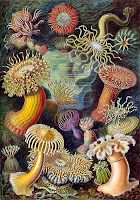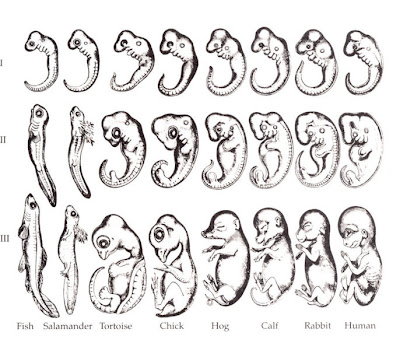 Some of the odd developments (gill slits and tails as examples) can be explained by the research of a 19/20th century German researcher, Ernst Haeckel. This eminent man was more than a scientist, he was a physician, philosopher, artist and teacher. Haeckel’s contribution to biology was immense, in addition to naming and identifying thousands of new species, he contributed many large-scale concepts to the fields of ecology and biology. His most controversial theory is often referred to as Recapitulation Theory.
Some of the odd developments (gill slits and tails as examples) can be explained by the research of a 19/20th century German researcher, Ernst Haeckel. This eminent man was more than a scientist, he was a physician, philosopher, artist and teacher. Haeckel’s contribution to biology was immense, in addition to naming and identifying thousands of new species, he contributed many large-scale concepts to the fields of ecology and biology. His most controversial theory is often referred to as Recapitulation Theory.This theory is often stated as "Ontogeny recapitulates phylogeny", simply meaning that as an organism develops, it replays its evolutionary history. His theory is closely tied to the figure below (redrawn by Romanes in 1892), which shows striking similarities in the various stages of development of some vertebrates. We now know that Haeckel, perhaps in an attempt to bolster his theory or perhaps because his specimens were incomplete, embellished the drawings to some degree; so these examples must be taken with a grain of salt but hey are correct in a generalized sense. Haeckel, a great believer in the works of Charles Darwin, used this illustration and many of his other drawings to support the theory of evolution and argued that as an individual develops, it repeats the full evolutionary development of its species.
 Now strictly speaking, Haeckel wasn’t exactly right, and a developmental biologist would set you straight about exactly how wrong Haeckel was, but I’m not going to be debating this point because no modern biologist would taken his theory to be literally true. What I would like to focus on is the broader picture that Haeckel’s observations support. We are all fundamentally related and simply, those of us that share a closer common ancestor will look more alike. So it is not a surprise that we resemble other mammals more closely than we resemble a fish, frog or reptile. Also, evolutionary steps are often like ‘additions’, adding new features to the developing form, so again it is not a surprise that our own human embryos go through stages resembling that of other animals.
Now strictly speaking, Haeckel wasn’t exactly right, and a developmental biologist would set you straight about exactly how wrong Haeckel was, but I’m not going to be debating this point because no modern biologist would taken his theory to be literally true. What I would like to focus on is the broader picture that Haeckel’s observations support. We are all fundamentally related and simply, those of us that share a closer common ancestor will look more alike. So it is not a surprise that we resemble other mammals more closely than we resemble a fish, frog or reptile. Also, evolutionary steps are often like ‘additions’, adding new features to the developing form, so again it is not a surprise that our own human embryos go through stages resembling that of other animals.If Haeckel were to be taken literally, at some point a growing human embryo would be a viable fish, amphibian, reptile, or early primate. But in fact a human embryo can only ever be a human. The commonalities we share with other animals that Haeckel discovered are indicative of our common ancestry and his theory helps us understand that stages in our embryonic development reflect these connections. Some of the weird things human embryos go through include:
• Early on the embryo develops gill slits (more correctly called pharyngeal arches) in its neck. In a human, the first gill bar (which supports the pharyngeal arch) develops into the lower jaw as well as the ear bones (malleus and the stapes). The gill slits will then close, leaving just one open for the development of the ear opening
• By the fourth week a clear tail is seen in the human embryo. It recedes after a few weeks and these tissues form what is commonly known as the tailbone (coccyx).
• Around the fifth month of gestation the embryo develops lanugo, a fine, downy hair, which covers its entire body. It provides some insulation, as the child has little in the way of fat reserves. This hair is usually lost by birth, though is often seen on premature infants.




Comments